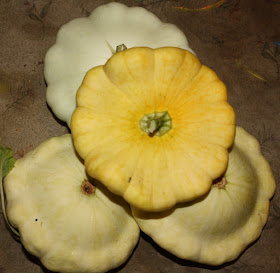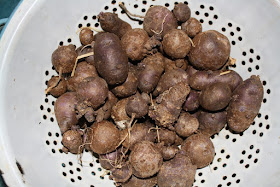Since I just got all of my harvest records for the year finally put into a spread sheet, I thought I'd celebrate by doing a bit of a recap of the garden year so far.
January was a bit sparse, due to a lack of planting in the fall. Most of the harvest was salad greens, with a few radishes, beets and turnips. Total weight was 7.54 pounds, worth $28.75. (at average equivalent retail pricing)
February was more of the same, with a wider variety of greens, herbs and edible flowers coming in, along with broccoli and pea shoots. February's harvest was 12.88 pounds, worth $56.47.
March was more salad mix, along with carrots, turnips, celery. peas, green onions and mixed greens for cooking. March's harvest weighed 25.63 pounds, worth $81.05 March also saw the beginnings of the poultry flock, with the purchase of 4 hens and a rooster.
April gave lots more salad mix and cooking greens plus two types of snow peas, broccoli, asparagus and my first ever artichoke.
May gave even more greens, artichokes, strawberries, purple beans, potatoes and the first small tomatoes. May's harvest weighed 21.575 pounds and was worth $90.85.
In June the garden really started revving up, while for the most part tender salad greens were non-existent, many other things were coming right along, potatoes, carrots, cooking greens, lots of tomatoes along with peaches and plums. June's harvest weighed 101.88 pounds, worth $314.61. June also saw an expansion of the poultry flock with 5 ducklings.
July's harvest topped June's by a few pounds and a greater variety. More tomatoes, corn, eggplant, squash, summer apples and herbs. July's harvest totals were 112.41 pounds worth $195.49. July saw a large leap in the poultry flock with the acquisition of 4 Welsummer poults, 11 Muscovy ducks and a broody hen hatching out 4 chicks.
Total year to date, from an average size yard, not fully developed or planted yet, is 311 pounds of fruits and vegetables worth $747.22. And of course the year is only half over. I have a feeling that August to December will bring in even more than the first half of the year did. For one thing, fall will bring lots of pumpkins and winter squash. Also I'll be planting a lot of crops for the fall and winter months as well as things that will winter over and be harvested early next spring.
I haven't yet rounded up all my receipts and tallied up expenses, but I'm pretty sure that even with the high price of water this summer I'll come out to the good when all is said and done.



















































